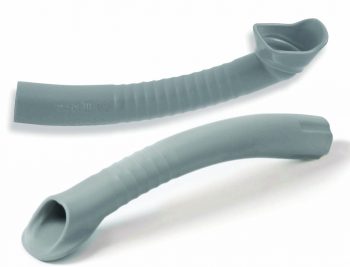Maximize the Removal of Dental Aerosols
Different dental procedures require varying tools, just as a contractor would not hammer a screw in when building a home—it might do a similar job, but it is nowhere as effective. The same applies to the comparison between high-volume evacuation (HVE) and saliva ejectors. Saliva ejectors tend to be used during routine and straightforward procedures where fluid needs to be removed from the patient’s mouth. Whereas HVEs are necessary during more extensive dental work because of their ability to reduce aerosol production by 90-98%.1 Understanding the appropriate and proper use of both tools is vital.
The Flow Rate and Suction Volume
Performing dental procedures can be challenging if a practice’s vacuum system/HVE is inadequate.2 Without a proper vacuum system, dental professionals could be making efforts to prevent aerosol contamination without correctly judging the airflow level that produces adequate suction for clinical purposes.3 Many dental team members have walked into the office, flipped the switch on to the vacuum, compressor, and water without thinking about the system being fully functional. The airflow rate should be monitored or checked periodically to ensure the system is functioning properly. This has become even more important during the current pandemic. There is more to understand regarding the use of this great engineering control that is meant to reduce the risk of spreading aerosols, including the required minimum airflow levels for producing adequate suction.

HVE Air Protect XL Plus with 360º Swivel Head (top) and HVE Air Protect XL (bottom).
Routine Maintenance and Cleaning
Recommendations for routine maintenance and care are not just for dental patients. The evacuation systems should be properly maintained for optimal and continual use. Each day, a team member should run a non-corrosive and biodegradable solution through the lines to help support the vacuum system’s optimal use. If you are performing surgical procedures or intense non-surgical procedures that may have more blood suctioned from the mouth, you may want to clean the lines after the procedure. Daily cleaning of the evaluation lines helps to penetrate and remove line buildup while maintaining vacuum performance and suction. It is important to be very strategic about your cleaning solution choice. Some solutions may not be compatible with amalgam separators, leaching mercury from amalgam, or potentially corrode the vacuum system. Solutions that are non-foaming are ideal because foam solutions can obstruct the flow of air, which creates a suction or pass through the separation tank into the suction pump. The foam could then dry and cause the pump to fail.
HVEs are necessary during more extensive dental work because of their ability to reduce aerosol production by 90-98%.
Cleaning and proper maintenance of the vacuum system will help ensure the reduction of aerosols through your preferred HVE tip. Without daily cleaning, the vacuum’s suction can weaken and not adequately remove the aerosols. Monarch CleanStream Evacuation System Cleaner from Air Techniques has a unique formulation designed specifically for daily cleaning. It penetrates and removes line buildup while maintaining vacuum performance and improving suction power.
HVEs Are Far Superior To Saliva Ejectors
Although saliva ejectors are useful during routine dental procedures, they do not have the power needed to limit the spread of aerosols. After all, aerosols can remain in the air and travel throughout the dental practice, posing a risk to the entire team, even after the infected patient has left the building.4 The use of a high-volume evacuator dramatically reduces the risk of these aerosols escaping from the patient’s mouth.
Air Techniques new autoclavable HVE Air Protect XL and HVE Air Protect XL Plus (with 360° swivel head) maximize dental aerosol absorption right at the source, the patient’s mouth. Both HVE tips have a larger opening allowing for more aerosols to be captured, providing more protection for patients and staff. The secondary air inlets prevent backflow from the suction system reducing the risk of cross-contamination.
The HVE Y-Adapter converts a standard 11mm HVE opening to accommodate the 16 mm Air Protect XL and Air Protect XL Plus.
The Y-adaptor was specifically designed for clinicians working without an assistant that still want the benefits of an HVE. The saliva ejector is placed in the small opening and placed in the oral cavity for liquid removal while the Air Protect XL Plus, located on the side of the mouth, reduces aerosols.
HVE Tips Without High-Performance Vacuum Systems
Yes, we will need a saliva ejector to help the pooling of fluid in the patient’s mouth, but HVE will be what is needed for most of our procedures in dentistry. We create spatter, spray, and aerosols for most of what we do so becoming accustomed to using our HVE is incredibly important. However, we have to think past the HVE tip and consider the vacuum system that is really the workhorse in the situation.
To help eliminate infectious aerosols spreading throughout dental offices, the Mojave Dry Vacuum5 can “provide the highest operational performance” required. The higher-flow vacuum is consistent and provides an exceptional level of suction without the noise levels of older models. It can adjust speed to accommodate the number of users online without the performance suffering.
Maximize dental aerosol absorption right at the source.
The system will always provide the right speed, suction, and flow to ensure a safe and reliable dental procedure for both the patient and the staff. With low maintenance and offering 85% energy savings compared to other systems, the Mojave can save dentists money.
HVE’s are amazing engineering controls and should be the choice for aerosol reduction during dental procedures. We just have to remember they only work when we use them and only as good as the vacuum system to support their performance.
Resources
- “High Volume Evacuator (HVE) – MedCrave” 16 May. 2018, Accessed 14 Sep. 2020.
- “Aerosols and splatter in dentistry – NCBI” 29 Dec. 2014, Accessed 14 Sep. 2020.
- “Determination of minimum suction level necessary for field dental units” PubMed. Accessed 20 Sep. 2020.
- “Aerosols and splatter in dentistry – NCBI” 29 Dec. 2014, Accessed 14 Sep. 2020.
- “Mojave LT 3 – Air Techniques.” Accessed 14 Sep. 2020.

Michelle Strange, MSDH, RDH for Air Techniques
Michelle Strange brings over 20 years of experience to her numerous roles in dentistry. A graduate of the Medical University of South Carolina with a Bachelor’s of Health Science and the University of Bridgeport with a Master’s in Dental Hygiene Education, she focuses her career on expanding the knowledge of her colleagues in all aspects of health care. Her passion for dentistry and its connection to overall health extends to her community and global efforts. Currently, she is the co-founder and co-host of the longest-running podcast for dental hygienists, A Tale of Two Hygienists, LLC, the co-founder of Level Up Infection Prevention, LLC, and TriviaDent, LLC, a practicing dental hygienist, and Client Success Manager for MouthWatch, LLC.
Permission to publish provided by Air Techniques
Published in TIPS – May/June 2021
Category: Merchandise
Back to Articles